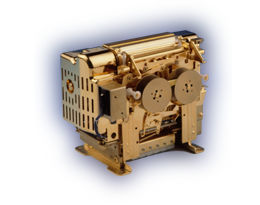During the 1980s EPSON was synonymous with dot matrix printers.
 Many
knew it was a Japanese company but very few knew Epson was also a subsidiary
of Seiko, the watch manufacturers. The name Epson derives from the Son of electronic
printer (EP-101) - a printer which Seiko developed for the 1964 Tokyo Olympics.(1)
Many
knew it was a Japanese company but very few knew Epson was also a subsidiary
of Seiko, the watch manufacturers. The name Epson derives from the Son of electronic
printer (EP-101) - a printer which Seiko developed for the 1964 Tokyo Olympics.(1)
This printer went into serial production 1968
From Perry's visit Japan set forth on the road to modernisation. In 1872 the first railway opened and the western time system was adopted. Three years later the first Japanese clock factory began. Other clock factories followed including the K. Hattori Trading Company in 1881. The founder, Kintaro Hattori, established the Seikosha factory in 1892 and began to produce wall clocks. Within 18 months Seikosha employed 90 staff, and by the turn of the century some 400. (Seikosha means something like Precision Manufacturing Company.)
After 100 years in business the company is still owned by the Hattori family with no outside stockholders. Most of the world's supply of "Swiss" watch movements are actually made by Seikosha. In addition, Seikosha operates under three different corporations - sometimes in direct competition and under other brand names.
Diama Seikosha makes watches which are then sold to overseas markets under the brand name "Seiko". Suwa Seikosha developed the quartz watch over an eight-year period and also manufactures electric shavers, spectacle lenses, and ICs, as well as other products. It is also the parent company of Epson Corporation.
Electronic watches using relatively high current light-emitting diodes first appeared on the market in 1970 and so Shinshu Seiki began researching a low-current alternative. It came up with the liquid-crystal display in 1974 which in turn led to LCD watches.
Epson America was incorporated in 1975 with offices being set up in Torrance, California to distribute Shinshu Seiki products.
An improved version, the MX-80, began to be developed later in that same year. The TX-80 took three months to develop. The MX-80 took about two years, was introduced in late 1980, quickly became the best selling printer in the United States, and eventually became the industrial standard for microcomputers. This was despite it being designed not to produce graphics. Within a year the Graftrax version with graphics had hit the streets.
Software for the QX-10 was developed by Rising Star Industries. This company was incorporated at the end of 1982 (by Epson?), drawing its name from the Rising Sun of Japan and the Stars and Stripes of USA :-(
Shinshu Seiki changed its name to Epson Corporation about the same time. Also in that year Epson announced the HX-20 computer. Termed a 'briefcase' portable computer, it offered a built-in printer and microcassette data storage system. From 1980 to 1983 Epson America grew from 17 employees to over 260.
| 1964 | - | High-precision crystal chronometers and printing timers (Tokyo Olympics) |
| 1968 | - | Printer mechanism, EP-101 |
| 1969 | - | Quartz watch |
| 1973 | - | Digital wristwatch |
| 1982 | - | Notebook computer (HX-20) |
| - | Wristwatch-sized LCD TV | |
| 1983 | - | Battery-powered 3.5" floppy disk drive (SMD 200) |
| 1984 | - | Full-color LCD TV (ET-10) |
| 1985 | - | DOS-based PC |
| - | Memory card (SRAM) | |
| - | Plastic-packaged oscillator | |
| 1988 | - | Printer manufactured totally by automation |
| 1989 | - | Single-pass color flatbed scanner |
| 1990 | - | Wristwatch pager |
| 1992 | - | Light hardening lens production system |
| 1994 | - | Desktop color ink jet printer with 720 x 720 dpi resolution (EPSON Stylus Color) |
| 1995 | - | Smallest, lightest and brightest LCD projector (ELP-3000) |
| 1997 | - | 1440 dpi high resolution colour inkjets |
![]()
| Last Updated on October 7, 2002 | For suggestions please mail the editors |
Footnotes & References
| 1 | "The Epson QX-10 User's Guide", James M. Hansen, 1984. |
| 2 |
//www.embassy.org.nz/computer/epson.htm |
| 3 | ep-101 picture from www.epson.de |
| 4 | table from www.epson-europe.com + www.epson.co.uk |